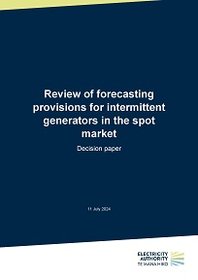Forecasting provisions for intermittent generators
Decision
We have decided to implement a hybrid forecasting arrangement to improve the accuracy of intermittent generation forecasts and offers.
This initiative is a key building block to improve the reliability, efficiency and affordability of the electricity system, which supports our statutory objective. It is also intended to support competition and innovation by reducing barriers to entry for new developers.
The arrangement relies on a centralised forecast with the option for self-forecasting if it is at least as accurate as the centralised forecast.
To give effect to the hybrid arrangement, we have decided to implement several key policy design measures. These changes aim to ensure intermittent generators’ offers are as accurate as possible during all trading periods.
We will undertake a procurement process to select a service provider to provide a centralised forecasting service and we intend to have the new arrangements in place by winter 2025.
Our decision paper presents the key findings and decisions from our review. We have also created guidance to provide clarity to intermittent generators on how the provisions in the Code relating to resource persistence forecasting should be interpreted.
Consultation
This consultation sought feedback on proposed solutions to improve the accuracy and frequency of intermittent generation forecasts.
We have observed that intermittent generation forecasts are often inaccurate and unreliable until close to real time. Inaccurate forecasting is prevalent because there are minimal obligations around the accuracy of intermittent generation forecasts. Intermittent generators have few incentives to forecast accurately as there is little correlation between forecasting accuracy and revenue earnt in the spot market.
It is estimated that the share of supply from intermittent generation will increase from around 6% of total generation today to 47% by 2050. In the shorter term, 78% of actively pursued projects that could be completed by 2025 are solar projects, with wind projects accounting for most of the remaining generation potential. Therefore, it is an appropriate time to review the forecasting arrangements for intermittent generators.
Thanks to all who provided valuable input into this consultation. We are carefully considering all submissions to decide which option to progress.
Submissions
-
Consumer Advocacy Council3 pages
-
Contact Energy8 pages
-
ETSI12 pages
-
NewPower Energy5 pages
-
Genesis Energy10 pages
-
Helios Energy5 pages
-
Lodestone Energy4 pages
-
Manawa Energy2 pages
-
Mercury Energy4 pages
-
Meridian Energy9 pages
-
Major Electricity Users Group2 pages
-
Nova Energy7 pages
-
Transpower10 pages

